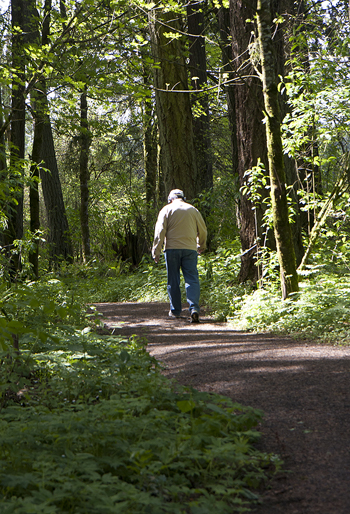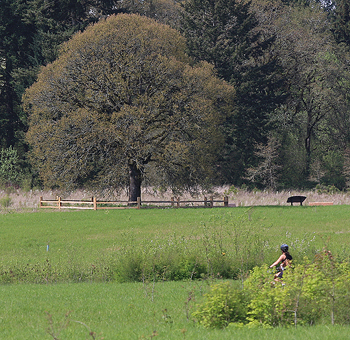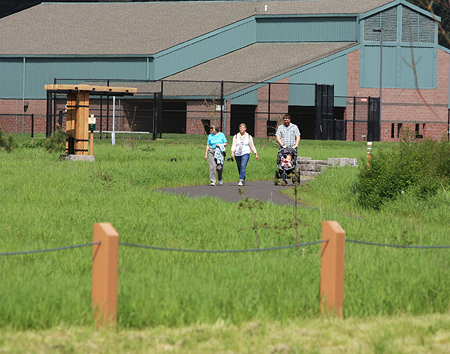Sitting in a grove of trees, overlooking a creek, listening to the birds, bugs and other wildlife, it’s hard to believe this place was slated to be a prison.
Thanks to local officials fighting and lobbying, now are area just west of Wilsonville is a nature area where children learn about nature, and every day hundreds of people bike, walk, stroll or simply sit and talk in a 250-acre nature park.
With three-miles of trails that cover 250 acres, the park is as much educational as it is an outdoor workout area and nature reserve.
For years the property was farmed, with a large White Oak sitting in the middle of it – looking like an Ansel Adams photo throughout the year. As development encroached the area, it became part of a state mental health hospital and was planned to be a new women’s prison.
Through the hard work of a family that pioneered the Wilsonville area, the park was born, and with it the replanting of 15,000 White Oaks to try to recreate the savannah that was once on the property. Each year the saplings grow larger and larger, and experts are hoping that this will repopulate the once abundant White Oaks that were around the Willamette Valley.
While history is a big part of Graham Oaks, another is looking forward. The first thing you notice when you pull into the main parking lot off Wilsonville Road are the bathrooms with solar panels and the covered picnic area with a “green roof.” Each special area has a interpretive sign that tells you the benefits of that type of development.
 With the green roof, plants are put on top of buildings to clean rain water and give more filtration to water before it enters the storm drain system and the rivers. But green roofs and solar panels isn’t where the park stops being environmentally friendly. All of the design, materials and construction of the park promote environmental stewardship of natural resources in many ways. Even the parking lots were built with pervious pavement, to lessen the amount of storm water that is created into the Wilsonville city storm water system.
With the green roof, plants are put on top of buildings to clean rain water and give more filtration to water before it enters the storm drain system and the rivers. But green roofs and solar panels isn’t where the park stops being environmentally friendly. All of the design, materials and construction of the park promote environmental stewardship of natural resources in many ways. Even the parking lots were built with pervious pavement, to lessen the amount of storm water that is created into the Wilsonville city storm water system.
While much of the park is wide open grassland – you can see Villebois, the city’s mixed-use development as a backdrop – my favorite part is Legacy Creek Trail, a gravel trail off the main paved Tonquin Trail. This short trail ducks into a grove of trees and follows a creek and is under the cover of conifer trees. There are places to stop and sit and just listen and view the wildlife and nature, a wonderful scene to be sure. With Northern harriers, belted kingfishers and orange-crowned warbler, it’s a bird watchers heaven. But don’t worry, there are plenty of mammals too.
Along the trials there are five different plazas, where you can learn more about the history or fauna of the park area. One of the unique plazas is the Acorn Plaza, which features a 6,000-pound acorn sculpture that you can see children climb or rest on after a bike ride or walk. Interpretive signs tell the story in each of the plazas about everything from the tribes of Indians that lived in the area to the family who farmed the property.
Education is a large part of Graham Oaks, as it is located right next to Boones Ferry Primary School, Inza R.Wood Middle School and CREST environmental education center. Students can be seen in the park on a regular basis studying the wildlife habitat and cultural history of the park.
So whether you want to take a break, get a workout, ride a bike, learn about squirrels or simply take a walk in nature, Graham Oaks Nature Area is a great waypoint for whatever you want to do.
 About Graham Oaks Nature Park:Three miles of trails traverse Graham Oaks, allowing visitors to explore several habitats in a single park. Cyclists and joggers can take the paved Tonquin Trail, which eventually will connect Wilsonville, Tualatin and Sherwood. A spur trail leads to a wetland overlook, perfect for bird-watchers; Coyote Way meanders through young oak woodlands. For a bit of shade, follow the Legacy Creek Trail through a rich conifer forest where thousands of species thrive. Be sure to visit Graham Oaks’ five plazas – perfect spots to rest, reflect and learn about the park. Be on the lookout for native wildlife such as white-breasted nuthatch, Western bluebird, orange-crowned warbler and Western gray squirrels.
About Graham Oaks Nature Park:Three miles of trails traverse Graham Oaks, allowing visitors to explore several habitats in a single park. Cyclists and joggers can take the paved Tonquin Trail, which eventually will connect Wilsonville, Tualatin and Sherwood. A spur trail leads to a wetland overlook, perfect for bird-watchers; Coyote Way meanders through young oak woodlands. For a bit of shade, follow the Legacy Creek Trail through a rich conifer forest where thousands of species thrive. Be sure to visit Graham Oaks’ five plazas – perfect spots to rest, reflect and learn about the park. Be on the lookout for native wildlife such as white-breasted nuthatch, Western bluebird, orange-crowned warbler and Western gray squirrels.
What to bring: The entire park is outdoor. Take a guess what you should bring, that’s right, weather appropriate clothing. There are covered picnic areas and the park is OK to ride a bike in. Personally every time I bring my camera to the park I walk away with some great photos.
Tip: Along the trails there are pamphlets that will tell you what is going on in the area at other Metro parks and even programs that will be offered at Graham Oaks. Also, don’t be afraid to get off the pavement and walk along the gravel trails, they are well kept and offer some amazing glimpses into nature.
Season: The park is open from 6:30 a.m. to legal sunset daily, year-round.
Getting there: From Interstate 5, take the Southwest Wilsonville Road exit (283); go west on Wilsonville Road. Graham Oaks Nature Park is approximately 1.5 miles west of Interstate 5, on the right. The nature park is adjacent to Inza R. Wood Middle School, Boones Ferry Primary School and CREST environmental educational center.
SMART regional transit provides service from Wilsonville Station to the park via the 4-Wilsonville Road line. The 2x Barbur provides service between Barbur Transit Center and Wilsonville Station.
By Patrick Johnson
For Oregon.com

 With the green roof, plants are put on top of buildings to clean rain water and give more filtration to water before it enters the storm drain system and the rivers. But green roofs and solar panels isn’t where the park stops being environmentally friendly. All of the design, materials and construction of the park promote environmental stewardship of natural resources in many ways. Even the parking lots were built with pervious pavement, to lessen the amount of storm water that is created into the Wilsonville city storm water system.
With the green roof, plants are put on top of buildings to clean rain water and give more filtration to water before it enters the storm drain system and the rivers. But green roofs and solar panels isn’t where the park stops being environmentally friendly. All of the design, materials and construction of the park promote environmental stewardship of natural resources in many ways. Even the parking lots were built with pervious pavement, to lessen the amount of storm water that is created into the Wilsonville city storm water system. About Graham Oaks Nature Park:Three miles of trails traverse Graham Oaks, allowing visitors to explore several habitats in a single park. Cyclists and joggers can take the paved Tonquin Trail, which eventually will connect Wilsonville, Tualatin and Sherwood. A spur trail leads to a wetland overlook, perfect for bird-watchers; Coyote Way meanders through young oak woodlands. For a bit of shade, follow the Legacy Creek Trail through a rich conifer forest where thousands of species thrive. Be sure to visit Graham Oaks’ five plazas – perfect spots to rest, reflect and learn about the park. Be on the lookout for native wildlife such as white-breasted nuthatch, Western bluebird, orange-crowned warbler and Western gray squirrels.
About Graham Oaks Nature Park:Three miles of trails traverse Graham Oaks, allowing visitors to explore several habitats in a single park. Cyclists and joggers can take the paved Tonquin Trail, which eventually will connect Wilsonville, Tualatin and Sherwood. A spur trail leads to a wetland overlook, perfect for bird-watchers; Coyote Way meanders through young oak woodlands. For a bit of shade, follow the Legacy Creek Trail through a rich conifer forest where thousands of species thrive. Be sure to visit Graham Oaks’ five plazas – perfect spots to rest, reflect and learn about the park. Be on the lookout for native wildlife such as white-breasted nuthatch, Western bluebird, orange-crowned warbler and Western gray squirrels.